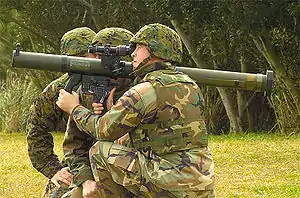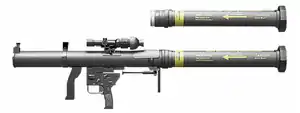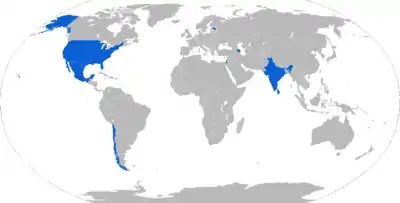| B-300 | |
|---|---|
 | |
| Type | Anti-tank |
| Place of origin | Israel |
| Service history | |
| Used by | See Operators |
| Wars | Lebanese Civil War 1st and 2nd Intifada 2006 Lebanon War Gaza War 2020 Nagorno-Karabakh conflict |
| Production history | |
| Designer | Israel Military Industries |
| Designed | 1970s |
| Manufacturer | Israel Military Industries |
| Produced | 1980s–present |
| Specifications | |
| Mass | 3.65 kg (8.0 lb) empty 8 kg (18 lb) loaded |
| Length | 1,440 mm (57 in) |
| Crew | 1 |
| Caliber | 82 mm (3.2 in) |
| Rate of fire | 3 rounds per minute |
| Muzzle velocity | 280 m/s (920 ft/s)[1] |
| Maximum firing range | 400 m (1,300 ft) |
| Sights | Iron, telescopic, night vision |
The B-300 is a reusable man-portable anti-tank weapon system developed by Israel Military Industries in the late 1970s for use by the Israel Defense Forces. The B-300 can be carried and operated by a single operator and is effective to approximately 400 meters (1,312 ft).[2] Pre-packaged munitions and simple operating mechanisms make the weapon quite versatile, permitting use by airborne, motorized, and ground troops alike. When defence publications first heard reports of the B-300 in the early 1980s, various reports stated in error that it was an Israeli improved and manufactured version of the Russian RPG-7.[3]
Usage
Munitions used by the B-300 are propelled by a solid rocket motor, and can be equipped with one of two warhead variants. The first, high-explosive anti-tank round, provides specialized support for anti-tank missions. The second, known as a high-explosive follow-through round, is designed for use against fortified targets or enemy units behind cover. A primary charge punches a hole through the protective structure, allowing a secondary anti-personnel charge to pass through and detonate within the building. The B-300 was produced during the 1980s and entered service in limited quantities within Israeli Defence Forces SF units.
Further development
SMAW

The Shoulder-launched Multipurpose Assault Weapon (SMAW) is a shoulder-launched rocket weapon, designed by McDonnell Douglas, with the primary function of being a portable anti-armor rocket launcher. It entered service in the U.S. Marine Corps in 1984. It has a maximum range of 500 m against a tank-sized target.
Shipon

During the late 1990s, IMI introduced the Shipon, an advanced disposable multi-purpose shoulder-launched rocket system consisting of a launch tube and FCS module.[4] The Shipon includes an advanced fire-control system, helping to aim and increasing effective range to 600 meters.[5] The Shipon fires two types of rockets: HEAA Tandem, which penetrates 800 mm of steel armor after explosive reactive armor, and a bunker-buster rocket. The Shipon is in service within Israeli Special Forces units in the IDF and the YAMAM (the elite police counter-terror unit).
Operators

Current operators
 Azerbaijan
Azerbaijan Chile
Chile Estonia[6]
Estonia[6] India
India Israel
Israel Mexico
Mexico Singapore
Singapore Sri Lanka
Sri Lanka United States Used under the designation Mk153 SMAW.
United States Used under the designation Mk153 SMAW. Trinidad and Tobago[7]
Trinidad and Tobago[7]
See also
References
- ↑ Jane's Infantry Weapons 1984–85
- ↑ "IMI B-300 light anti-armour weapon". Jane's Information Group. 2007-06-26. Archived from the original on 2019-12-14. Retrieved 2008-10-30.
- ↑ "International Defense Digest". International Defense Review. No.11/1982. page 1495.ISSN 0020-6512 (SZ).
- ↑ "Shipon Ffe". Archived from the original on 2016-07-15. Retrieved 2016-05-18.
- ↑ "SHIPON Anti-Tank Weapon". Archived from the original on 4 December 2008. Retrieved 30 October 2008.
- ↑ "Granaadiheitja B-300". sodur.com. Archived from the original on September 7, 2011. Retrieved 2012-05-10.
- ↑ Doodnath, Alina (July 27, 2018). "Alfonso on possible future terror attacks: Let them try". Looptt.